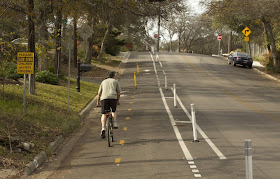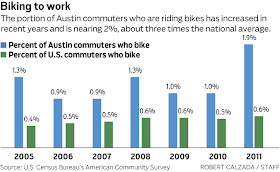 Searching the web today for work comps and I ran across some of the new stuff happening in Austin. Austin implemented a new two-way, buffered bikeway on Bluebonnet Lane and
Melridge Place, which runs about seven-tenths of a mile from near Rabb
Road (up the hill from Zilker Park) to near South Lamar Boulevard. The
track, installed by the city of Austin a couple of months ago, is a
harbinger of what is likely to be many such segregated bike lanes around
the city. Right now, Austin has three of them — Bluebonnet, Rio Grande
Street for five blocks near the University of Texas and the off-street
portions of the Lance Armstrong Bikeway.
Searching the web today for work comps and I ran across some of the new stuff happening in Austin. Austin implemented a new two-way, buffered bikeway on Bluebonnet Lane and
Melridge Place, which runs about seven-tenths of a mile from near Rabb
Road (up the hill from Zilker Park) to near South Lamar Boulevard. The
track, installed by the city of Austin a couple of months ago, is a
harbinger of what is likely to be many such segregated bike lanes around
the city. Right now, Austin has three of them — Bluebonnet, Rio Grande
Street for five blocks near the University of Texas and the off-street
portions of the Lance Armstrong Bikeway.But another is under construction on Barton Springs Road, the Rio Grande track will be extended another four blocks, and more are planned over the next year or so for Rainey Street, South Congress Avenue south of Live Oak Street and Berkman Drive in Mueller. The city is working on an overall network of “low stress” bicycle tracks. The thinking is that many more people would use a bike for basic transportation — including getting to and from work — if the element of fear could be removed from cycling. Cycle tracks, which separate the bike lanes from car lanes with a series of plastic pylons rather than merely a 4-inch strip of white paint, are seen as a way to provide that comfort.
Based on a U.S. census figures, about 1.9 percent of Austinites used a bike regularly to commute in 2011. That number might seem small, but it is about twice what census numbers have generally shown for Austin and three times the national average. It puts Austin in 11th place among U.S. cities.
The city’s goal is to have cyclists make up 5 percent of commuters by 2020. Thus the cycle tracks.
The four types of cyclists: less than 1 percent fall into that “strong and fearless” cohort, 7 percent are “enthused and confident,” 60 percent are “interested but concerned” and 33 percent say “no way no how.” It stands to reason that making biking safer would increase the commute percentage. Portland, which has installed an array of bike facilities over the past generation, saw the portion of commuting cyclists go from 1.2 percent in 1990 to a best-in-the-country 6.3 percent in 2011. But to get this perceived and actual bicycle safety, and the resulting increased use, motorists will have to sacrifice.
 Rio
Grande between Martin Luther King Jr. Boulevard and West 24th Street
used to be a two-lane street, with parallel parking on both sides. Now,
with the cycle track, it has either two lanes and no parking or, for
several blocks, one lane and parking on just one side of the road. On
Bluebonnet and Melridge, parking has been lost on the west side of the
street where the track runs. But there was no loss of driving lanes, and
lightly traveled streets like these are probably well-suited for giving
cyclists an alternative to a harrowing trip on South Lamar. The trade-off could be worth it. And not just to the enthused and confident.
Rio
Grande between Martin Luther King Jr. Boulevard and West 24th Street
used to be a two-lane street, with parallel parking on both sides. Now,
with the cycle track, it has either two lanes and no parking or, for
several blocks, one lane and parking on just one side of the road. On
Bluebonnet and Melridge, parking has been lost on the west side of the
street where the track runs. But there was no loss of driving lanes, and
lightly traveled streets like these are probably well-suited for giving
cyclists an alternative to a harrowing trip on South Lamar. The trade-off could be worth it. And not just to the enthused and confident.

The local officials of Austin deserve everyone's respect for doing their job well. The creation of cycle tracks surely helps the cyclists avoid the danger of collision in streets and highways. Kudos to them!
ReplyDelete